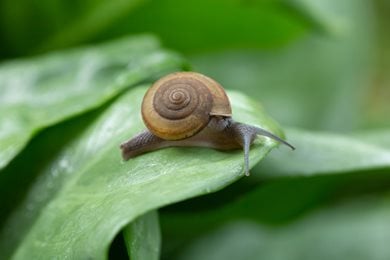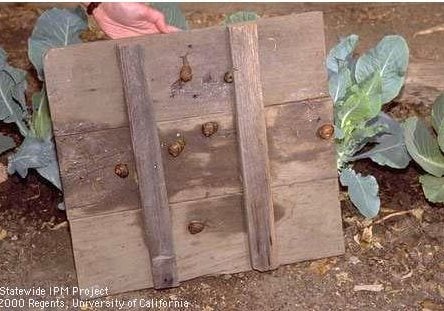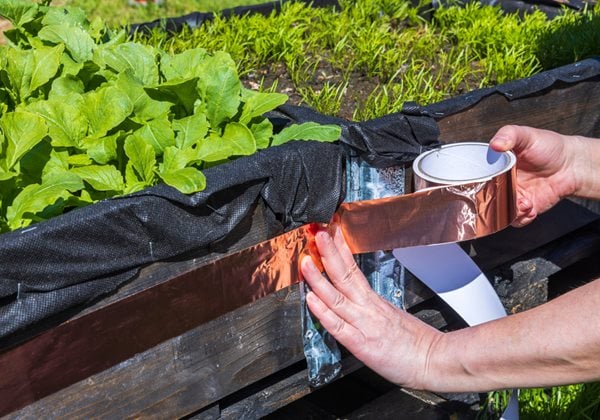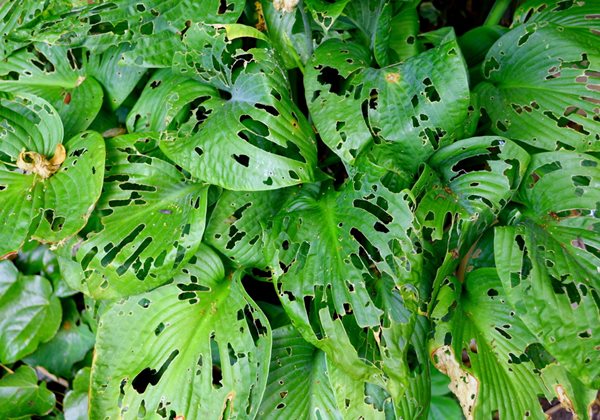8 Tips to Get Rid of Garden Snails & Slugs
Stop these destructive pests in their tracks using these eco-friendly control methods.
Both snails and slugs (which are simply snails without the spiral shells) tend to be most active at night and early in the day, when the soil is cool and moist. Photo by: foto76 / Shutterstock.
Are slugs and snails turning the leaves of your precious plants into Swiss cheese overnight? These menacing mollusks have voracious appetites, and even though they move at a snail’s pace (literally), they can do a lot of damage in a short time. They are notorious for chewing ugly holes into hosta leaves, but they will happily munch away on the tender foliage of all sorts of plants and will also feed on ripening fruits and vegetables.
Despite their destructive tendencies, slugs play an important role in the ecosystem by breaking down decaying plant matter and providing a food source for toads, turtles, snakes, and birds. If you prefer to keep slugs away from certain garden plants, rather than eliminating them altogether, several of these control methods can be used to ward them off without harm.
1. IDENTIFY THEIR PRESENCE
To avoid major damage to your plants, you should be on the lookout for slugs regularly, especially if they have been a problem in the past. Because these critters are most active at night or on cloudy days when it is cool and damp, you may need a flashlight to spot them. Be sure to check low-growing foliage and the soil underneath plants, especially in shaded areas. You can also find them hiding under rocks and flat stones.
Although slugs and snails vary in size and color, depending on the species, you can clearly identify them by their extensible eyestalks, which look a bit like alien antennae. Both pests will also leave behind a silvery slime trail as they move, a telltale sign of an infestation.
2. PICK THEM OFF BY HAND
This option is definitely not for the squeamish, but it can be quite effective when done on a regular basis. Every time you see a slug or snail, pick it off by hand (wearing gloves will make the chore less unpleasant) and dispose of it by tossing it into a bucket of soapy water. Because slugs like to hide during the day, you will have greater success handpicking after dusk or early in the morning.
3. SET A TRAP

Snails and slugs under a board trap. Photo courtesy University of California Regents
Instead of removing slugs from your plants one by one, set up simple slug and snail traps throughout the garden to nab a lot of these trespassers at one time and make them easier to dispose of. Inverted grapefruit or melon rinds work well, or create a shady retreat where slugs can take shelter on hot days by lying flat boards on the ground, slightly raised, so the slugs can crawl beneath them.
Another good home remedy is to fill a shallow container, such as a pie tin, with beer. Because slugs and snails are attracted to the yeasty aroma, they will crawl into the trap and drown. A mixture of sugar, water, and yeast is equally effective. The downside of beer traps is that they only work within a range of a few feet and must be replenished daily to make a significant impact.
Learn more about trapping slugs and snails from the University of California Integrated Pest Management Program (UC IPM).
4. CREATE AN UNFAVORABLE HABITAT
Slugs and snails love to hang out in moist, shady spots in the garden and in areas that are heavily mulched. They will also hide during the heat of the day under logs, branches, and piles of fallen leaves.
To make the habitat less hospitable, practice good housekeeping by removing plant debris and dead leaves from the garden, especially in the fall—the peak time for slugs and snails to lay their eggs. When using mulch, don’t apply it at a thickness greater than 3 inches, and keep it away from the base of your plants so slugs won’t burrow through it to reach covered stems.
Tip: Improve the air circulation in your garden by dividing and thinning plants, which will allow the soil surface to dry out more efficiently. Keeping the areas between plants drier will discourage slugs and snails from using them as pathways through the garden.
5. PUT UP A BARRIER

Applying copper tape to a raised bed. Photo by: Mulevich / Shutterstock
If you have raised beds for a vegetable or herb garden, copper tape applied along the edges or tops of the framework can be an effective method for keeping snails and slugs at bay. Their slime reacts with the copper to create an unpleasant sensation, similar to a mild electrical shock. If you don’t have raised beds, you can also wrap copper rings around individual plants, placing them at ground level. Just make sure that no leaves touch the ground outside the copper.
Dry diatomaceous earth, sprinkled in a continuous band around the perimeter of the garden, can also be an effective barrier because slugs don’t like its sharp, gritty consistency. However, it needs to be reapplied after rain or watering because it washes into the soil. For horticultural purposes, be sure to use food-grade diatomaceous earth or a product intended for pest control.
Tip: Although some gardeners claim to have success using coffee grounds or crushed eggshells as slug and snail deterrents, there is no clear evidence that they work, according to UC IPM. You’re better off using the tried-and-true methods above.
6. SWITCH TO DRIP IRRIGATION
Because slugs and snails love moisture, another good way to keep them off your plants is to use a drip irrigation system or soaker hose rather than overhead watering, so water won’t pool on the leaves. When you water matters, too. Always water in the morning so the soil has time to dry out by evening, when slugs are most active. You can also keep your garden on the dry side by growing drought-tolerant plants that don’t need frequent watering.
7. GROW PLANTS THEY DON'T LIKE

Snail and slug damaged hosta plant. Photo by: Savo Ilic / Shutterstock
There are few garden plants that slugs and snails won’t nosh on, but they are especially fond of basil, beans, cabbage, hostas, leafy vegetables, dahlias, marigolds, and strawberries. In areas of the garden where slugs and snails are particularly troublesome, you can send them packing by growing plants that won’t whet their appetites. Generally, they’ll steer clear of herbs with highly aromatic leaves (such as lavender, rosemary, and sage), most woody plants, ornamental grasses, and plants with leathery, fuzzy or prickly foliage.
Tip: Use plants that slugs and snails love, such as marigolds
8. APPLY AN ORGANIC SLUG BAIT
One of the best ways to get a jumpstart on preventing slugs is to apply an organic slug and snail bait in the spring, one that’s safe for use around pets, wildlife, and fruits or vegetables ready for harvest. Most of these products contain iron phosphate (a plant nutrient that naturally occurs in the soil), and they will remain effective after rain or watering, so you don’t need to reapply them often.
Avoid chemical slug baits or pellets that contain metaldehyde, a poison that can be toxic to people and pets when ingested. The best time to apply slug bait is in the late afternoon or evening, when snails and slugs are actively feeding.
RELATED:
How to Grow Tomato Plants
Getting Rid of Japanese Beetles
How to Get Rid of Grub Worms
